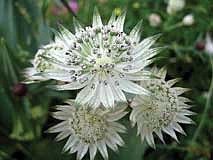
Garden News
June is considered to be one of the most floriferous months in the gardening calendar. With so much going on in the garden, it can be hard to make time to enjoy the fruits of our labour. Whilst I can’t always find the time during these months, it’s also a good time to get out and have a look at other gardens too. The NGS scheme is full of amazing gardens to visit throughout the summer, so make a point of clearing some space in the diary and get out and see what ideas you can acquire and adapt for your garden.Plant of the month – Astrantia
Astrantias are star plants of our summer borders and they’ve been blooming happily in British gardens since Tudor times. Their pincushion heads of minute cream, pink and green flowers, surrounded by papery green-tipped bracts, were once collected from the wild for medicinal use. The old English name for Astrantia ‘masterwort’, denotes their herbal use as a purgative or diuretic. However, their quiet beauty saw them established in cottage gardens, becoming ever showier as plantsmen and women, took advantage of the Astrantias readiness to hybridise and set seed.
If you grow these starry perennials, you’ll know that many of the newer hybrids come in dark colours, from blood red to deep purple and near black. These dark types are the most sought after and are mostly cultivars or varieties of Astrantia major – a European native which has an extensive root system and relishes substantial soil in damp meadows and at woodland margins. The flowers are borne from May to October on branching stems up to 2ft high. The leaves are palmate, glossy green and form vigorous mounds. Its flowers are held on fine stems radiating from a central point and a ruff of bracts protects them and their seeds. It is easy to see where the pin-cushion analogy comes from. After pollination each seed is suspended, trembling, on its own hair-fine stem. The papery bracts remain presentable for months, rustling in every breeze.
Astrantias are accommodating plants but will do best in a soil that doesn’t become too dry. They prefer to be planted in light or dappled shade. When planting ensure to dig in deeply and incorporating lots of organic matter. planting in sunnier positions, it is particularly important to add plenty of that good old muck.
After flowering, Astrantias can be rejuvenated by cutting them back close to the ground – fresh new foliage and a late crop of flowers start appearing shortly after. Astrantias don't spread far but are well known for self-seeding, so be prepared to either increase your stock of them or weed them out when they appear where you don’t want them.
One of my favourite combinations would be to plant Astratia with the Ostrich fern – Matteucccia struthiopteris. The pale green fronds of the ferns seem to be the perfect textural compliment to those delicate pin cushion flowers. Astrantia can also make excellent dried flowers however I wouldn’t recommend using them as a cut flower. Although they look great in an arrangement, if you put them straight from the garden into a vase, they tend to make the whole room smell alike dead flies!
Jobs to be doing this month include:
Ornamental Garden:
• Lightly trim box balls – traditionally on Derby Day 6th June!! Would be nice to encourage the box topiary to grow larger while retaining the shape.
• Deadheading – Salvias as the flower heads go over, penstemons, roses etc.
• Spray any plants infected with aphids or black fly.
• Weed!!!
• Prune early flowering clematis.
• Cut back foliage of tulips.
• Trim other shrubs to shape as necessary.
• Plant warm season grasses such as penisetum and panicum
• Treat bindweed/groundelder and other invasive weeds growing among other plants by applying a glyphosate based weedkiller to their leaves.
• Prune ornamental cherries after their flowers have faded.
• There is still time to sow quick germinating annuals such as cosmos.
• Sow winter bedding such as violas etc.
• Cut back oriental poppies/pulmonaria etc after they have flowered. Remove all leaf as well to allow for fresh leave to sprout.
• Remove reverted shoots form variegated shrubs etc.
Vegetable Garden:
• Direct Sow carrots for autumn and winter harvest
• Sow Florence fennel and chicory.
• Plant out leeks once they are pencil thick.
• Put straw round strawberries.
• Water potatoes for good sized tubers.
• Feed tomatoes regularly
• Ventilate greenhouse.

